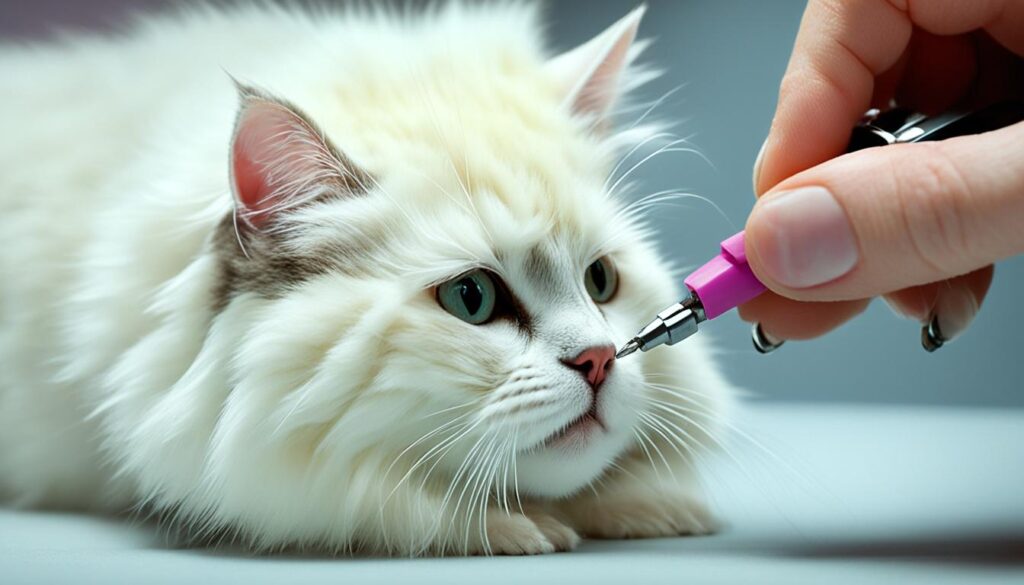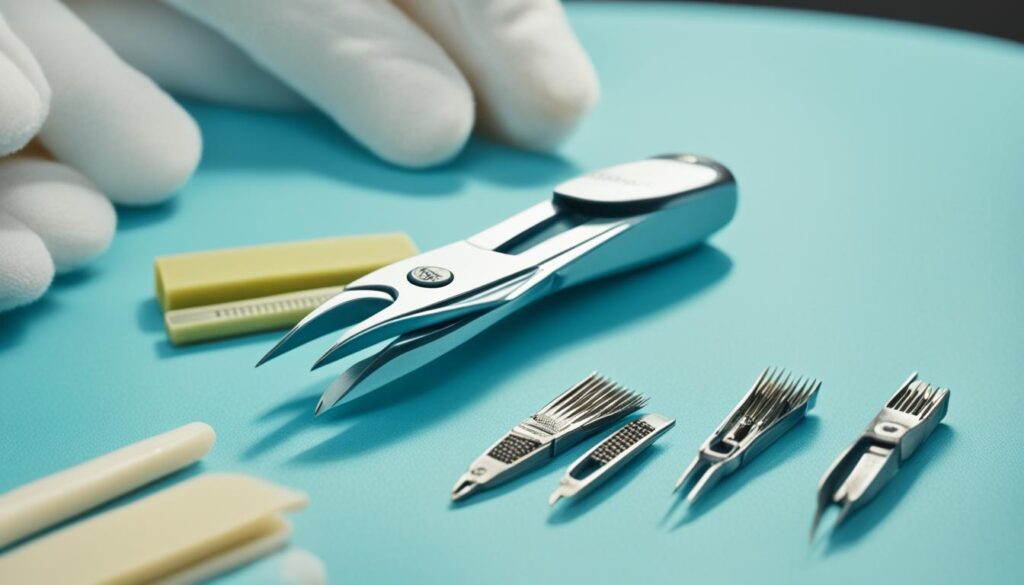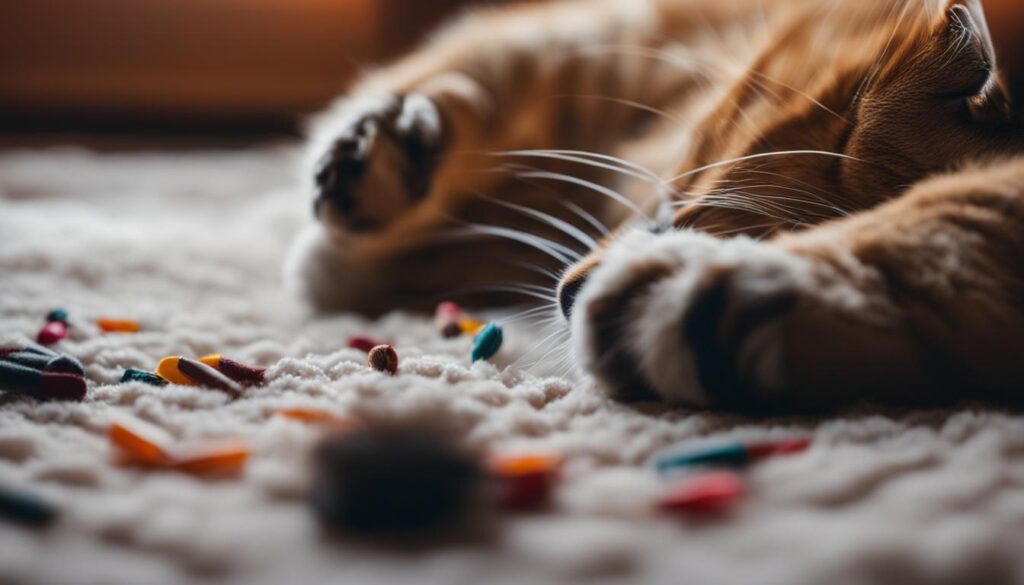Dear cat owners, we all know that our feline friends hold a special place in our hearts. Those intricate little paws, with their adorable pads, remind us of the love and companionship they bring into our lives. But when those nails start to get a little too long and sharp, it can be a challenge to ensure the safety and well-being of both you and your furry companion. That’s why we’re here to help you master the art of cat nail trimming in the safest and most effective way possible.
Whether you’ve had some less-than-pleasant experiences with nail-cutting sessions in the past or you’re a newbie looking for guidance, this article will provide you with expert tips and techniques to make the process stress-free and comfortable for both you and your cat.
Key Takeaways:
- Regular nail care is essential for your cat’s paw health.
- Proper tools and techniques can make nail trimming safe and effective.
- Create a calm environment and help your cat become accustomed to nail trimming.
- Learn the step-by-step instructions for trimming your cat’s nails with ease.
- Address common concerns and practice safety precautions during the process.
Understanding the Importance of Cat Nail Care
Before diving into the specifics of cat nail cutting, it’s crucial to recognize the significance of nail care for your feline companion. Proper cat nail care, including regular trimming and grooming, plays a vital role in maintaining your cat’s overall paw health and well-being.
Regular nail trimming benefits your cat in multiple ways:
- Preventing Ingrown Nails: By keeping your cat’s nails at an appropriate length, you can reduce the risk of painful ingrown nails. Overgrown nails can curl into the paw pads, causing discomfort and possible infection.
- Protecting Furniture and Belongings: Cats have a natural instinct to scratch and sharpen their claws. By regularly trimming their nails, you can prevent excessive scratching, protecting your furniture, curtains, and other household items from damage.
- Minimizing Scratching-Related Injuries: Untrimmed nails can lead to accidental scratches or injuries to both you and your cat. By keeping your cat’s nails well-maintained, you can reduce the risk of scratches and potential infections.
- Promoting Physical Comfort: Overgrown nails can alter a cat’s gait and posture, leading to discomfort and potential musculoskeletal issues. Proper nail care ensures your cat can move and walk comfortably.
- Maintaining Healthy Paws: Trimming your cat’s nails allows you to regularly inspect their paws for any signs of infection, injury, or abnormalities, enabling early intervention and proper care if needed.
Incorporating regular nail care into your cat’s grooming routine is essential for their overall health and happiness. By investing time in cat nail care, you’re taking proactive measures to prevent common nail-related problems and create a comfortable living environment for both you and your feline friend.
Next, let’s explore the essential tools you’ll need for cat nail trimming, ensuring a safe and effective grooming experience for you and your cat.
Gather the Necessary Tools for Cat Nail Trimming
To trim your cat’s nails properly, you’ll need a few essential tools. Here’s a list of items you’ll need for a successful at-home cat nail trimming session:
- Nail clippers: Choose nail clippers specifically designed for cats. There are two main types available: guillotine-style clippers and scissor-style clippers. Test both styles to see which one you and your cat prefer.
- Nail file or grinder: After trimming the nails, a nail file or grinder can help smooth any rough edges. Opt for a file or grinder designed for cats, as human tools may cause discomfort.
- Treats: Use treats as positive reinforcement during the nail trimming process. Reward your cat with a treat after each successful nail trim to create a positive association.
- Towel or blanket: Having a towel or blanket nearby can help you gently restrain your cat if needed. It provides a sense of security and reduces potential movement during the nail trimming.
- Styptic powder or cornstarch: In case of accidental bleeding, keep styptic powder or cornstarch on hand to stop bleeding quickly. Apply a small amount to the nail tip to aid in clotting.
Remember, choosing the right tools for your cat is crucial for a safe and effective nail trimming session. Take the time to familiarize yourself with the tools and ensure they are clean and well-maintained before use.
Having the necessary tools ready will make the cat nail trimming process smoother and more efficient. Let’s move on to the next section, where we’ll discuss how to prepare your cat for nail trimming.
Preparing Your Cat for Nail Trimming
Before starting the nail trimming process, itâs crucial to create a calm and relaxed environment for your cat. By following these step-by-step instructions, you can help your cat become accustomed to nail trimming and make the experience more comfortable for both of you.
Step 1: Choose the Right Time
Find a time when your cat is most relaxed, such as after a nap or a meal. Avoid trimming their nails when they are anxious or agitated.
Step 2: Gather the Supplies
To ensure a smooth nail trimming session, gather all the necessary supplies beforehand. You will need:
- Nail clippers designed specifically for cats
- Treats or rewards to motivate and reward your cat
- A soft towel or blanket to provide a comfortable surface
Step 3: Create a Calm Environment
Find a quiet, well-lit room where you can trim your cat’s nails without distractions. Play relaxing music or use a white noise machine to create a soothing atmosphere.
Step 4: Get Your Cat Acclimated
Handle your cat’s paws gently and reward them with treats to get them comfortable with having their paws touched. Gradually increase the time you spend handling their paws to desensitize them to the sensation.
Step 5: Familiarize Your Cat with the Nail Clippers
Show your cat the nail clippers and let them sniff and investigate them. This will help them become familiar with the tool and reduce any apprehension.
Step 6: Introduce Paw Massages
Before nail trimming, gently massage your cat’s paws to promote relaxation. This will help them associate the trimming process with a positive experience.
Step 7: Stay Calm and Patient
During the nail trimming session, remain calm and patient. If your cat shows signs of stress or discomfort, take a break and try again later. It’s important not to rush the process.
Following these steps will help create a positive environment and prepare your cat for a successful nail trimming session. By taking the time to familiarize your cat with the process and using patience and gentle techniques, you can make nail trimming a stress-free experience for both you and your feline companion.
Proper Techniques for Cat Nail Trimming
Trimming your cat’s nails can be a daunting task, but with the right technique and approach, it can become a manageable and stress-free experience for both you and your furry friend. Follow these step-by-step guidelines to ensure a successful cat nail trimming session:
1. Prepare the necessary tools
Before you begin, gather the essential tools for cat nail trimming. You will need:
- Nail clippers or a nail trimmer specifically designed for cats
- A styptic powder or cornstarch to stop bleeding, in case you accidentally cut too close to the quick
- Treats or rewards to reward your cat’s cooperation
2. Find a comfortable location
Select a quiet and well-lit area where you and your cat can feel relaxed. Ensure that the surface you choose is stable and secure, allowing your cat to remain calm throughout the process.
3. Get your cat accustomed to handling
Handle your cat’s paws regularly, even when you’re not trimming their nails. Start by gently touching their paws, then progress to holding them for short periods. This will help your cat become familiar with the sensation of having their paws touched and reduce resistance during nail trimming.
4. Choose the proper angle
Hold your cat’s paw firmly but gently, ensuring you have a clear view of the nails. Take care not to apply excessive pressure that could cause discomfort. Position the clippers or trimmer at a slight angle, avoiding cutting straight across. This helps prevent the nails from splitting.
5. Trim with caution
Trim the tip of each nail, staying approximately 1-2 millimeters away from the quickâthe pink area within the nail. It’s better to trim a small amount at a time rather than risking cutting too close to the quick. If you’re unsure, it’s best to consult a professional groomer or veterinarian for guidance.
6. Monitor your cat's reactions
While trimming your cat’s nails, observe their reactions closely. If your cat shows signs of discomfort, such as pulling their paw away or vocalizing, take a break and offer reassurance. It’s important to prioritize your cat’s comfort throughout the process.
7. Reward and praise
After successfully trimming your cat’s nails, reward them with treats and praise. Positive reinforcement will help create positive associations with nail trimming sessions, making future sessions more manageable.
Remember, patience and practice are key when it comes to cat nail trimming. If you’re uncertain or uncomfortable trimming your cat’s nails, consider seeking professional help. A groomer or veterinarian can offer guidance and ensure that the process is done safely and effectively.

Now that you’re familiar with the proper techniques for cat nail trimming, you can confidently maintain your cat’s nail health and prevent any unwanted issues that may arise from overgrown nails.
Tips for Nail Trimming with a Cooperative Cat
If you’re one of the lucky cat owners whose feline friend is cooperative during nail trimming sessions, we have some tips and tricks to make the process even easier. With a little guidance, you can ensure a positive experience for both you and your cat.
Create a Calm Environment
Before you begin the nail trimming session, make sure your cat is in a calm and relaxed state. Find a quiet and comfortable space where you can both feel at ease. Dim the lights, play some soothing music, or use pheromone sprays to create a calming atmosphere.
Use Positive Reinforcement
Positive reinforcement is key to maintaining your cat’s cooperation during nail trimming. Reward your cat with treats and praise throughout the process to make them associate nail trims with positive experiences. Offering treats after each successful trim can help create a sense of accomplishment for your cat.
Start Slowly and Gradually
If your cat is new to nail trimming, begin by gently touching and massaging their paws regularly. This will help desensitize them to having their paws handled and make the nail trimming process less stressful. Gradually introduce the clippers or nail trimmer, allowing your cat to sniff and familiarize themselves with the tool before proceeding.
Expert Tip: If your cat shows signs of stress or discomfort, stop the nail trimming session and try again later. Patience is key when working with a cooperative cat.
Enlist a Friend or Family Member
If you have a particularly cooperative cat, having an extra pair of hands can make the process even smoother. Enlist the help of a friend or family member to hold your cat gently and securely while you trim their nails. This way, you can focus on safely and accurately trimming the nails without worrying about restraining your cat.
Take Breaks If Needed
Even with a cooperative cat, patience can wear thin. If you or your cat feel overwhelmed or agitated during the nail trimming session, take a break. It’s important to prioritize your cat’s comfort and well-being. Resume the session when you both feel calm and ready to continue.
Follow these tips, and nail trimming with your cooperative cat will be a breeze. Remember to always prioritize your cat’s comfort and offer plenty of positive reinforcement throughout the process.
| Benefits | Tips |
|---|---|
| Prevent ingrown nails | Use sharp and clean nail clippers or trimmers |
| Reduce scratching-related issues | Trim nails in a well-lit area for better visibility |
| Minimize damage to furniture and surfaces | Make sure your cat is calm and relaxed before trimming nails |
| Improve overall paw health | Reward your cat with treats and praise for cooperation |
Dealing with Resistant Cats During Nail Trimming
If your cat is resistant to nail trimming, you’re not alone. Many cat owners face this challenge. However, with the right strategies and gentle techniques, you can make the process less stressful for both you and your feline friend.
Here are some helpful tips to handle your resistant cat during nail trimming:
- Start Slow: Gradually introduce your cat to the concept of nail trimming. Begin by gently touching their paws and rewarding them with treats or praise.
- Positive Reinforcement: Use positive reinforcement techniques to associate nail trimming with pleasant experiences. Offer treats or engage in playtime before and after each session.
- Desensitization: Gradually increase the duration of paw handling sessions to desensitize your cat. Start with short sessions and gradually extend them over time.
- Distraction: Use interactive toys or treats to redirect your cat’s attention during nail trimming. This can help keep them engaged and less focused on the trimming process.
- Seek Assistance: If your cat remains uncooperative, consider seeking the help of a professional groomer or veterinarian experienced in handling resistant cats.
Remember:
Patience is key when dealing with a resistant cat. Take breaks if necessary and respect your cat’s boundaries. Pushing them too far may cause stress and further resistance. It may take time, but with consistency and positive reinforcement, you can eventually make nail trimming a more comfortable experience for your cat.
| Common Challenges with Resistant Cats | Effective Strategies to Overcome Challenges |
|---|---|
| Lack of trust or fear | Build trust gradually, using treats and gentle handling |
| Kicking or scratching | Wrap your cat in a towel or use a gentle restraint technique |
| Hissing or growling | Use calming techniques like soothing music or pheromone sprays |
| Quick movements or resistance | Proceed slowly, offering rewards for small moments of compliance |
Addressing Common Concerns and Safety Precautions
When it comes to cat nail trimming, many pet owners have common concerns. It’s important to address these concerns and take necessary safety precautions to ensure a safe and stress-free experience for both you and your cat. Here are some tips to help you navigate through the process:
1. Avoiding Accidental Injuries
Accidental injuries can happen during nail trimming if you’re not careful. To minimize the risk:
- Choose a well-lit area with good visibility.
- Be cautious of the quick, the sensitive part of the nail that contains blood vessels and nerves.
- Trim only the sharp tips of the nails and avoid cutting too close to the quick.
- If you’re unsure, use a nail trimmer with a built-in guard to prevent overcutting.
2. Dealing with Accidentally Cutting Too Much
If you accidentally cut too much of your cat’s nail and it starts bleeding, don’t panic. Here’s what you can do:
Apply gentle pressure with a clean cloth or styptic powder on the bleeding nail to encourage clotting. If the bleeding doesn’t stop within a few minutes, consult your veterinarian for further guidance.
3. Recognizing Signs of Discomfort or Pain
It’s important to be attentive to your cat’s body language and behavior during nail trimming. Look out for signs of discomfort or pain, such as:
- Excessive licking or biting of the paws
- Flattened ears or hissing
- Tail swishing or aggressive behavior
- Attempts to escape or hide
If you notice any of these signs, it’s best to stop the nail trimming session and consult a professional for assistance.
Remember, patience and a calm approach are key when it comes to cat nail trimming. By taking necessary precautions and addressing common concerns, you can ensure a safe and positive experience for both you and your feline companion.
Addressing common concerns and following safety precautions is crucial for safe cat nail cutting and trimming.
Maintaining Consistency with Cat Nail Care
Consistency is key when it comes to cat nail care. By establishing a regular routine for nail trimming, you can ensure your cat’s paws stay healthy and prevent any potential issues. Let’s explore the recommended frequency for nail trimming and other aspects of cat nail care.
Recommended Frequency for Nail Trimming
For most cats, trimming their nails every 2 to 4 weeks is sufficient to maintain proper length and prevent them from becoming too sharp or pointed. However, the frequency may vary depending on your cat’s individual needs. Some cats may require more frequent trimming, especially if they have fast-growing nails or are prone to scratching furniture.
Establishing a Nail Care Routine
To establish a nail care routine that works for both you and your cat, it’s important to follow these steps:
- Find a quiet and comfortable space: Choose a quiet area where your cat feels relaxed and secure. This could be a designated grooming area or a quiet room in your home.
- Introduce your cat to the nail trimming process: Start by gently touching your cat’s paws and gradually introduce the nail clippers or trimmers. Offer treats and praise to create positive associations with the process.
- Begin with short trimming sessions: Start with short trimming sessions to get your cat used to the process. Gradually increase the length of each session as your cat becomes more comfortable.
- Trim only the tip: When trimming your cat’s nails, only remove the sharp tip to avoid cutting into the quickâa sensitive area that can cause bleeding.
- Reward your cat: After each successful nail trimming session, reward your cat with treats and praise. This positive reinforcement helps create a positive experience for your feline companion.
Remember, patience and a gentle approach are key when it comes to maintaining consistency with cat nail care. With time, your cat will become more comfortable with the process, making nail trimming a stress-free activity for both of you.

Proper cat nail care involves consistent trimming and attention to your feline friend’s paw health. By following a routine and using gentle techniques, you can ensure your cat’s nails stay well-maintained and prevent any discomfort or issues. In the next section, we’ll explore alternative methods for cat nail maintenance, providing you with additional options for keeping your cat’s nails in top shape.
Alternatives to Nail Trimming for Cat Nail Maintenance
While regular nail trimming is the most common method for maintaining your cat’s nail health, there are alternative approaches available. These alternatives can help naturally file down your cat’s nails, providing a convenient and stress-free option for both you and your feline companion.
Scratching Posts
A scratching post is not only a key component of your cat’s environment but also a great way to naturally wear down their nails. With a variety of scratching post options, including those made of sisal, carpet, or cardboard, you can find one that suits your cat’s preferences. Encourage your cat to use the post by placing it near their favorite lounging spot, incorporating catnip, or gently guiding their paws to the post.
Nail Caps
Nail caps are small, soft covers that you can apply to your cat’s nails. They are available in various sizes and colors, providing a safe and effective alternative to nail trimming. Nail caps can be easily applied at home and can last for several weeks, gradually falling off as your cat’s nails grow. Remember to consult your veterinarian for guidance on nail cap application and removal.
Scratching Boards
Scratching boards are designed to provide a textured surface for your cat to scratch and file their nails. These boards are often made of sisal or other rough materials that mimic tree bark, offering a satisfying scratching experience for your cat. Place the scratching board near your cat’s favorite scratching area and encourage them to explore and use it regularly.
By incorporating these alternatives into your cat’s nail care routine, you can provide them with options for natural nail maintenance, reducing the need for frequent trimming. Observing your cat’s preferences and offering a variety of alternatives can help keep their nails in optimal condition while enriching their environment.
Seeking Professional Help for Cat Nail Trimming
If you’re unsure about trimming your cat’s nails at home or if your cat has specific needs, seeking professional help can be a good option. An experienced veterinarian or professional groomer can provide expert guidance and ensure the safety and well-being of your furry friend.
Professional cat nail trimming services offer several benefits. Firstly, these experts have extensive knowledge and experience in handling cats and their grooming needs. They are trained to perform nail trims efficiently and effectively, minimizing the risk of accidental injuries. Additionally, professionals have access to specialized tools and techniques that can make the process smoother and less stressful for your cat.
Moreover, some cats may have unique situations or conditions that necessitate professional assistance. For example, if your cat has extremely long or overgrown nails, the expertise of a professional can be invaluable in safely and comfortably trimming them. Similarly, if your cat exhibits aggression or fear during nail trimming, a professional can employ strategies to manage their behavior and ensure a positive experience for both you and your cat.
Remember, seeking professional help does not mean that you’ve failed as a cat ownerâit simply shows your commitment to your cat’s well-being. The ultimate goal is to provide the best care for your feline companion, and sometimes that may mean relying on the expertise of professionals.
When to Consult a Veterinarian or Professional Groomer
It’s essential to know when to seek professional help for cat nail trimming. Consider the following situations:
- If you’re inexperienced or uncomfortable with trimming your cat’s nails and prefer to leave it to trained professionals
- If your cat has a medical condition or is on medication that requires specialized attention during nail trimming
- If your cat has extremely long or overgrown nails that require professional expertise to trim safely
- If your cat exhibits aggression, fear, or resistance during nail trimming that cannot be managed effectively at home
- If you’re unable to safely restrain your cat or feel that you may harm your cat or yourself during the process
By recognizing the need for professional assistance and seeking it when necessary, you can ensure that your cat’s nail trimming experience is stress-free and comfortable.
Next, we’ll conclude our guide by summarizing the essential points covered throughout this article and offering additional tips on maintaining your cat’s nail health and overall grooming routine.
Conclusion
Learning how to cut your cat’s nails safely is an essential part of their overall grooming routine. By following the tips and techniques outlined in this article, you can maintain your cat’s nail health and ensure their paw’s well-being at home.
Remember to prioritize your cat’s comfort throughout the nail trimming process. Create a calm and relaxed environment, use proper techniques, and be patient with your furry friend. Consistency is key, so establish a routine that works for you and your cat to maintain healthy nails.
In addition to nail trimming, explore alternative options like scratching posts, nail caps, and scratching boards to naturally file down your cat’s nails. If you’re unsure or your cat has specific needs, don’t hesitate to seek professional help from a veterinarian or professional groomer.
By taking care of your cat’s nails, you can prevent common issues like ingrown nails and scratching-related problems. Keep your cat’s paws healthy and ensure their overall well-being. Happy trimming!
FAQ
How often should I trim my cat’s nails?
It is recommended to trim your cat’s nails every 2-3 weeks to maintain their paw health and prevent issues like overgrowth and ingrown nails.
Can I use human nail clippers to trim my cat’s nails?
It is not recommended to use human nail clippers as they may cause discomfort or injury to your cat. Opt for specially designed cat nail clippers or nail trimmers.
How do I handle my cat’s resistance during nail trimming?
If your cat is resistant, try gradually introducing them to the process, using treats and positive reinforcement, and keeping the sessions short and calm to help them get accustomed.
What should I do if I accidentally cut too much and cause my cat to bleed?
If you accidentally cut too much and cause bleeding, apply styptic powder or cornstarch to the nail tip to stop the bleeding. If the bleeding doesn’t stop or the wound appears serious, consult your veterinarian.
How can I make nail trimming a positive experience for my cat?
Make nail trimming a positive experience by associating it with treats, praise, and rewards. Use calming techniques, such as gentle strokes and soft music, to create a relaxing environment.
Are there alternatives to nail trimming for maintaining my cat’s nail health?
Yes, alternatives include using scratching posts, boards, or providing your cat with scratching pads. These help naturally file down their nails while satisfying their scratching instincts.
When should I seek professional help for cat nail trimming?
You should seek professional help if you are uncomfortable trimming your cat’s nails or if your cat has specific needs or medical conditions that require the expertise of a veterinarian or professional groomer.
How can I establish a routine for cat nail care?
To establish a routine, start by introducing nail trimming gradually and consistently. Choose a specific day and time, and be patient and consistent in your approach to make it a regular part of your cat’s grooming schedule.
Can I use nail caps to prevent scratching and nail damage?
Yes, nail caps can be an effective way to prevent scratching and nail damage. They are small vinyl caps that can be glued onto your cat’s nails and last for several weeks. However, they require regular maintenance and monitoring.



